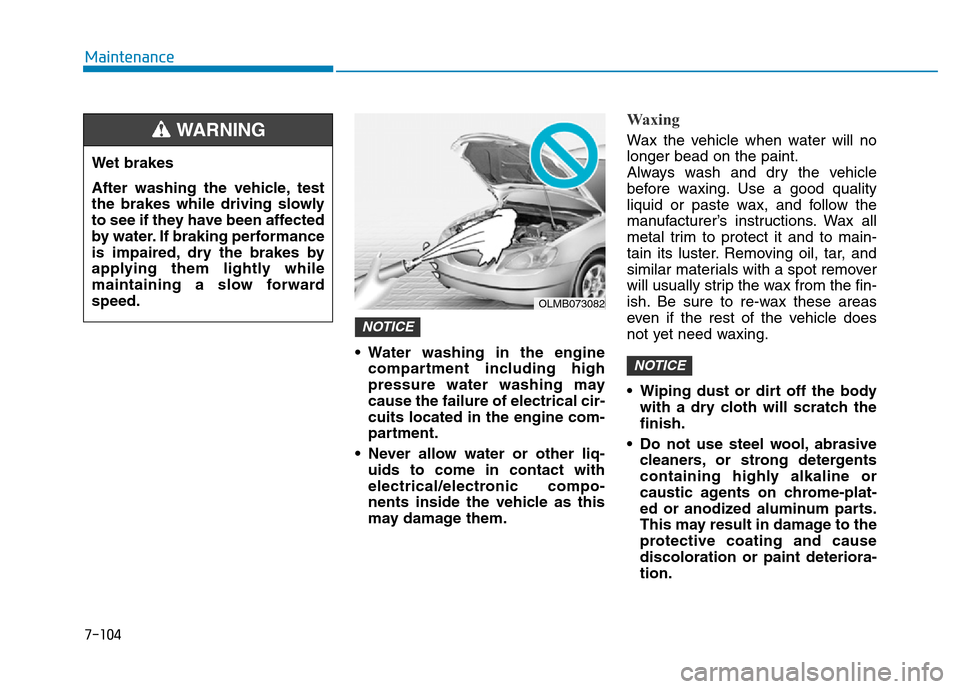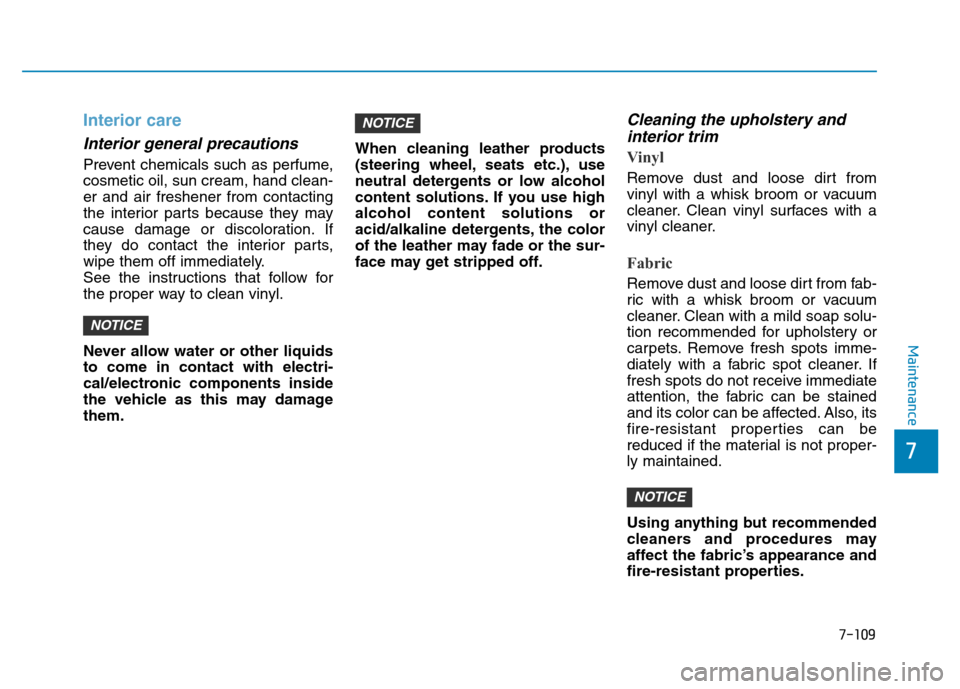Page 615 of 637

7-104
Maintenance
• Water washing in the engine
compartment including high
pressure water washing may
cause the failure of electrical cir-
cuits located in the engine com-
partment.
• Never allow water or other liq-
uids to come in contact with
electrical/electronic compo-
nents inside the vehicle as this
may damage them.
Waxing
Wax the vehicle when water will no
longer bead on the paint.
Always wash and dry the vehicle
before waxing. Use a good quality
liquid or paste wax, and follow the
manufacturer’s instructions. Wax all
metal trim to protect it and to main-
tain its luster. Removing oil, tar, and
similar materials with a spot remover
will usually strip the wax from the fin-
ish. Be sure to re-wax these areas
even if the rest of the vehicle does
not yet need waxing.
• Wiping dust or dirt off the body
with a dry cloth will scratch the
finish.
• Do not use steel wool, abrasive
cleaners, or strong detergents
containing highly alkaline or
caustic agents on chrome-plat-
ed or anodized aluminum parts.
This may result in damage to the
protective coating and cause
discoloration or paint deteriora-
tion.
NOTICE
NOTICE
Wet brakes
After washing the vehicle, test
the brakes while driving slowly
to see if they have been affected
by water. If braking performance
is impaired, dry the brakes by
applying them lightly while
maintaining a slow forward
speed.
WARNING
OLMB073082
Page 620 of 637

7-109
7
Maintenance
Interior care
Interior general precautions
Prevent chemicals such as perfume,
cosmetic oil, sun cream, hand clean-
er and air freshener from contacting
the interior parts because they may
cause damage or discoloration. If
they do contact the interior parts,
wipe them off immediately.
See the instructions that follow for
the proper way to clean vinyl.
Never allow water or other liquids
to come in contact with electri-
cal/electronic components inside
the vehicle as this may damage
them.When cleaning leather products
(steering wheel, seats etc.), use
neutral detergents or low alcohol
content solutions. If you use high
alcohol content solutions or
acid/alkaline detergents, the color
of the leather may fade or the sur-
face may get stripped off.
Cleaning the upholstery and
interior trim
Vinyl
Remove dust and loose dirt from
vinyl with a whisk broom or vacuum
cleaner. Clean vinyl surfaces with a
vinyl cleaner.
Fabric
Remove dust and loose dirt from fab-
ric with a whisk broom or vacuum
cleaner. Clean with a mild soap solu-
tion recommended for upholstery or
carpets. Remove fresh spots imme-
diately with a fabric spot cleaner. If
fresh spots do not receive immediate
attention, the fabric can be stained
and its color can be affected. Also, its
fire-resistant properties can be
reduced if the material is not proper-
ly maintained.
Using anything but recommended
cleaners and procedures may
affect the fabric’s appearance and
fire-resistant properties.
NOTICE
NOTICE
NOTICE
Page 621 of 637
7-110
Maintenance
Cleaning the lap/shoulder belt
webbing
Clean the belt webbing with any mild
soap solution recommended for
cleaning upholstery or carpet. Follow
the instructions provided with the
soap. Do not bleach or re-dye the
webbing because this may weaken it.
Cleaning the interior window
glass
If the interior glass surfaces of the
vehicle become fogged (that is, cov-
ered with an oily, greasy or waxy
film), they should be cleaned with
glass cleaner. Follow the directions
on the glass cleaner container.
Do not scrape or scratch the
inside of the rear window. This
may result in damage to the rear
window defroster grid.
CAUTION
Page 632 of 637

8-6
Specifications & Consumer information
R RE
EC
CO
OM
MM
ME
EN
ND
DE
ED
D
L
LU
UB
BR
RI
IC
CA
AN
NT
TS
S
A
AN
ND
D
C
CA
AP
PA
AC
CI
IT
TI
IE
ES
S
To help achieve proper engine and powertrain performance and durability, use only lubricants of the proper quality.
The correct lubricants also help promote engine efficiency that results in improved fuel economy.
These lubricants and fluids are recommended for use in your vehicle.
Lubricant Volume Classification
Engine oil *
1*2
(drain and refill)
RecommendsNu 2.0 MPI4.0l
(4.23 US qt.)Except Middle East,
Morocco, Sudan, EgyptAPI SM*
4& ILSAC GF-4 (or above)
ACEA A5*
3(or above)
For Middle East,
Morocco, Sudan, EgyptACEA A5*
3(or above)
Gamma 1.6
MPI3.6 l
(3.80 US qt.)Except Middle East,
Morocco, Sudan, EgyptAPI SM*
4& ILSAC GF-4 (or above)
ACEA A5*
3(or above)
For Middle East,
Morocco, Sudan, EgyptACEA A5*
3(or above)
U2 1.6 TCI5.3 l
(5.6 US qt.)with DPF ACEA C2 or C3*
5
without DPF ACEA B4*5
Manual transmission fluidNu 2.0 MPI/
U2 1.6 TCI1.7~1.8 l
(1.8~1.9 US qt.)HK MTF 70W (SK)
SPIRAX S6 GHME 70W MTF (H.K.SHELL)
GS MTF HD 70W (GS CALTEX) (API GL-4, SAE 70W) Gamma 1.6
MPI1.6~1.7 l
(1.7~1.8 US qt.)
Automatic transmission
fluidNu 2.0 MPI6.7 l
(7.08 US qt.)
MICHANG ATF SP-IV, SK ATF SP-IV, NOCA ATF SP-IV,
HYUNDAI genuine ATF SP-IV
Gamma 1.6
MPI6.7 l
(7.08 US qt.)
Page 633 of 637

8-7
8
Specifications & Consumer information
Lubricant Volume Classification
Dual clutch transmission fluid1.9~2.0 l
(2.01~2.11 US qt.)HK MTF 70W (SK)
SPIRAX S6 GHME 70W DCTF (H.K.SHELL)
GS MTF HD 70W (GS CALTEX)
(API GL-4, SAE 70W)
CoolantNu 2.0 MPIM/T5.9 l(6.23 US qt)
Mixture of antifreeze and water
(Phosphate-based Ethylene glycol coolant for
aluminum radiator) A/T5.8 l(6.13 US qt)
Gamma 1.6 MPIM/T5.7 l(6.02 US qt)
A/T5.6 l(5.92 US qt)
U2 1.6 TCI6.7 l (7.08 US qt)
Brake/Clutch fluid0.7~0.8 l
(0.74~0.85 US qt.)FMVSS116 DOT-3 or DOT-4
Fuel50 l(52.83 US qt.)Refer to “Fuel requirements” in the Foreword
chapter.
*1: Refer to the recommended SAE viscosity numbers on the next page.
*2: Engine oils labeled Energy Conserving Oil are now available. Along with other additional benefits, they contribute to fuel econ-
omy by reducing the amount of fuel necessary to overcome engine friction. Often, these improvements are difficult to measure
in everyday driving, but in a year’s time, they can offer significant cost and energy savings.
*
3: If the ACEA A5 engine oil is not available in your country, you are able to use ILSAC GF-3 (or above) or ACEA A3 (or above).
*4: If the API service SM engine oil is not available in your country, you are able to use API service SL.
*5: If the ACEA C2 or C3, B4 engine oil is not available in your country, you are able to use API CH-4 (or above).
Page 634 of 637

8-8
Specifications & Consumer information
Recommended SAE viscosity
number
Engine oil viscosity (thickness) has
an effect on fuel economy and cold
weather operating (engine start and
engine oil flowability). Lower viscosi-
ty engine oils can provide better fuel
economy and cold weather perform-
ance, however, higher viscosity
engine oils are required for satisfac-
tory lubrication in hot weather. Using
oils of any viscosity other than those
recommended could result in engine
damage.Always be sure to clean the area
around any filler plug, drain
plug, or dipstick before check-
ing or draining any lubricant.
This is especially important in
dusty or sandy areas and when
the vehicle is used on unpaved
roads. Cleaning the plug and
dipstick areas will prevent dirt
and grit from entering the
engine and other mechanisms
that could be damaged.
CAUTION
*1: For better fuel economy, it is recommended to use the engine oil of a viscosity grade SAE
5W-20
*
2: For better fuel economy, it is recommended to use the engine oil of a viscosity grade SAE
5W-30. However, if the engine oil is not available in your country, select the proper engine oil
using the engine oil viscosity chart.
*
3: Middle East includes Morocco, Sudan and Egypt.
When choosing an oil, consider the range of temperature your vehicle will be
operated in before the next oil change. Proceed to select the recommended
oil viscosity from the chart.
Temperature Range for SAE Viscosity Numbers
Temperature
Gasoline
Engine Oil
°C
(°F)-30 -20 -10 0 10 20 30 40 50
-10 0 20 40 60 80 100 120
For Europe
20W-50
10W-30
15W-40
5W-30*2, 5W-40
5W-30
15W-40
10W-30
0W-30
0W-40, 5W-20, 5W-30, 5W-40
Diesel Engine Oil
20W-50
15W-40
10W-30
5W-20*1, 5W-30
Except
Europe &
Middle
East*
3
For Middle
East*3
Page 637 of 637
8-11
8
Specifications & Consumer information
A compressor label informs you the
type of compressor your vehicle is
equipped with such as model, suppli-
er part number, production number,
refrigerant (1) and refrigerant oil (2).The radio frequency components of
the vehicle comply with requirements
and other relevant provisions of
Directive 1995/5/EC.
Further information including the
manufacturer's declaration of con-
formity is available on HYUNDAI
web site as follows:
http://service.hyundai-motor.com
CE0678
D DE
EC
CL
LA
AR
RA
AT
TI
IO
ON
N
O
OF
F
C CO
ON
NF
FO
OR
RM
MI
IT
TY
Y
■Example
OHC081001
A AI
IR
R
C
CO
ON
ND
DI
IT
TI
IO
ON
NE
ER
R
C CO
OM
MP
PR
RE
ES
SS
SO
OR
R
L
LA
AB
BE
EL
L